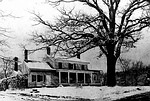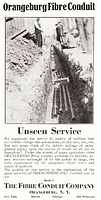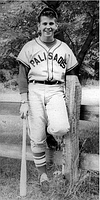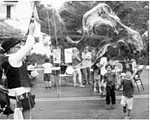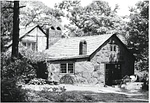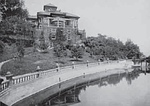The Palisades Historical Committee Reconvenes
The history of European settlement in Palisades goes back to 1687, when William Merritt bought land by the river and built the first house. Later, that same house became the home of Robert Sneden, who ran a ferry across the river. Winthrop Gilman, who moved here in 1861 and built the former Norman house on Ludlow Lane, became fascinated by the history of the hamlet and began to interview local residents and to collect a wide range of materials relating to the past, including the Gesner diary.
Read more...New Book Reveals Life in 19th Century Palisades
If you have ever wondered what life was like in Palisades 175 years ago, you might be interested in the book Nicholas Gesner, 19th Century Farmer, which I have just published. Gesner’s house, which he built in 1793, still stands on Closter Road.
Read more...Watch Fires On The Hudson
Without names, memories are lost.
Without memories, the past is lost.
Without the past, the future is lost.
Inscription on the Vietnam Veterans Memorial in Orangeburg
On Memorial Day, every year since 1987, the Vietnam Veterans of America Chapter 333 has kept watch for the fallen and missing servicemen of the Vietnam War by lighting massive beacon fires on the Piermont Pier, on Clausland Mountain, at Bowline Park and at Gene Levy Park in Rockland County. The fires are watched over by veterans taking shifts throughout the night, as they did in Vietnam from their base camps on mountain tops, when their comrades had not returned from patrol.
Read more...Orangeburg’s Most Famous Export
Often when a product is named after its birthplace, it isn’t intentional. It often happens as the result of associating the birthplace of an improvement or process to an existing product. Cement wasn’t invented in Portland (United Kingdom) but an abundance of superior raw material for cement turned a city of 13,000 people into a household name. For Orangeburg, New York, the product was fiber conduit, an inexpensive alternative to metal pipe produced by the Fibre Conduit Company.
Read more...WINTER IN PALISADES: Looking Back
I DON'T KNOW ABOUT YOU, but having lived in Palisades all my life, it doesn't seem as if winters are quite what they used to be. I attended Palisades Grammar School from kindergarten through 7th grade. The first few years were spent in the "old school," now the Palisades Community Center. We could bring our lunch or have the good fortune of eating a lunch that was prepared by Mrs. Groetz, a wonderful woman, who lived on Rt. 340. I really liked Mrs. Groetz because she always let me have seconds. The "old school," as we called it, housed four classes then.
Read more...THE INSIDE SCOOP ON THE FOUNDING OF 10964 ON THE OCCASION OF ITS 10TH ANNIVERSARY
IT WAS THE BEGINNING OF 1977 and the people of Palisades were concerned, some about one problem, others about another threat. One day we were informed that the Palisades School was to be closed and probably sold. A week later we heard of a plan for tractortrailers with even more sets of wheels to cruise down 9W. Oak Tree Road was being eyed as the truck route from New Jersey to upstate New York. Our sleepy hamlet was being threatened. It was a time when the people of Palisades needed to pull together. But while it was clear that issues affecting anyone in Palisades ultimately impacted upon everyone in the hamlet, there was not a sense of community cohesiveness, in part because two major roads split up our residential areas.
Read more...HAPPY BIRTHDAY: FORTY YEARS & GOING STRONG
1977: JIMMY CARTER BECOMES PRESIDENT, New York City experiences its first city-wide blackout, Elvis dies, the first Apple computer goes on sale and in March, the first issue of 10964 makes its way to the residents of Palisades. Throughout the following 40 years, our newsletter has recorded life in our hamlet, chronicling the achievements of our residents as well as their concerns about local issues affecting them.
Read more...Our Oldest House
The Big House was built of sandstone by Henry Ludlow around 1737. A matching wing was added on the left in 1821. In 1867 the roof was raised to make a second story and the veranda was added.
Read more...Rockland County's Own Ice Age
Not many exploitable natural resources can be touted as being infinitely renewable, clean and beneficial to public heath. Ice had all of this going for it and in 1863, Rockland county, specifically the Knickerbocker Ice Company, exported 200,000 tons of the commodity. Harvested from Rockland Lake and cut into fourinch- thick blocks, only half of the 400,000 tons harvested made it to its final destinations. The pure water of Rockland Lake, an abundance of sawdust from local mills to be used as insulation and its proximity to the Hudson River made it ideal for harvesting ice and storing it in specially designed ice houses. What really made this location successful was that it was 200 feet above sea level with a short, gentle and most importantly — downhill — trip to the barges and ships that would take the melting blocks as close as New York City and as far away as the Caribbean.
Read more...A History of Fundraising for the Palisades Free Library
The Palisades Free Library has survived 125 years because of the impassioned support of Palisadians who care about reading.
Read more...Palisades Parkway Seventieth Anniversary
70 years ago in 1946 the final design for a new, 42- mile interstate parkway from the George Washington Bridge to Bear Mountain was completed. The conception of a scenic drive along the Palisades was initially proposed in 1909 but did not gain traction until 1935 when John D. Rockefeller, Jr. donated the needed land in New Jersey to make a continuous highway possible. The parkway took 12 years and $47,000,000 to complete and was originally anticipated to handle 22% of all the traffic bound for the George Washington Bridge. Traveling mostly unnoticed, over 60,000 cars now pass through our town daily using the parkway.
Read more...Losing Our Historic Houses
Early in 1925, a small group of friends created the beginning of Woods Road in Palisades by clipping a path through the thick woods that had been part of the Peet farm before Mary Tonetti bought the land. They went on to build two charming, idiosyncratic houses on the new road, completed by that fall. They named the houses they built “The Thatched House” and “The House in the Woods.” The group consisted of Bobby Hyde, a free-spirited Californian who had married Lydia Tonetti and moved to Palisades, Lydia, and their friends Dick and Ruth Salmon.
Read more...The History of Slavery in Orangetown
In 1702 there were about forty white households in Orangetown, half of which owned a total of thirty-three African slaves. In 1790, there were 198 enslaved Africans living in seventy-eight white households and twenty-six free blacks. Ten years later, one year after the passage of the New York State Gradual Emancipation Act of 1799, there were 256 slaves in ninety-two white households and thirty-seven free blacks. More than two fifths of white households in Orangetown included Africans, both enslaved and free.
Read more...Mansions Along The Cliff
Tales of mansions that stretched for twelve miles along the cliffs of the New Jersey Palisades from Fort Lee to the N.Y. state border have fascinated many of us. Known as Millionaires’ Row, the wealthy in the mid-19th century were drawn to the river views and summer breezes. Most of these estates were knocked down with the construction of the Palisades Interstate Parkway; all that now remains are a few stone walls, a scattering of foundations and steps leading nowhere.
Read more...125 Years of Our Palisades Library
The first attempt to start a library in Palisades was a failure. At some time between 1863 when Dr. Cornelius Agnew arrived in Palisades and 1891, Dr. Agnew set up a fine library and reading room in the abandoned Steepleless Church, located where the Post Office now stands. (Sometime during the 1850s Nichols Gesner’s Methodist sect built a small church that was known as the Steepleless Church because it didn’t have a steeple.) However, it was soon vandalized and abandoned.
Read more...Bell's Birds
When Maria Gagliardi became the director of the Palisades Free Library she inherited an office with a large obstruction underneath the desk. It was a glass case filled with dusty taxidermied birds in various states of disrepair, as well as several holes and cracks in the case. Her interest piqued, it started a side project of investigation that led to a story of illustrious personages, murder most ‘fowl,’ and culminated in a splendid restoration by the American Museum of Natural History. We are lucky that it did not result in a more maudlin and appropriately Victorian end for the Library Director - death by arsenic poisoning.
Read more...Ghost Roads: The Carriage Path
Before there was a Palisades Parkway, before there were neighborhoods called Indian Hill or Palisades Gardens, in the 1920s there was a large estate that lay between Oak Tree Road, Closter Road, and Route 340, owned by Charles Nessler, the man who invented the permanent wave. This estate is remembered now chiefly because of the strange, Daliesque architecture of the house he built on it, and his herd of fallow deer. The estate also abutted the property of Nicholas Gesner who lived on Closter Road next to the New Jersey border and who had constructed a lane that went through his farm from Closter Road to Route 340. This lane was at one time known as “Gesner’s Lane” but for Robert Guttman and the other children growing up in the Indian Hill subdivision of the Nessler estate, the lane was known as “the carriage path” for reasons now long forgotten.
Read more...Ghost Roads: The Second in an Occasional Series on the Lost Lanes and Byways of Palisades
If you have read the books of Alice Munro Haagenson and her daughter Alice Gerard, you will know that at one time there was a mansion called Glen Forest on the cliff overlooking the Hudson in what is now Tallman State Park. Glen Forest was pulled down in 1932, but early maps of our hamlet show a long lane leading from Rockland Road to the mansion, with stone bridges crossing streams, and ending with a large sweeping circle at the cliff’s edge. They also show a croquet lawn on one side of the lane and gardens on the other. All that remains of the house is an overgrown hollow and a small flight of stones once forming a cellar.
Read more...Palisades Library To Acquire Historic Document
Recently, architect and historian Win Perry of Nyack came across an old handwritten copy of the Lockhart Patent, dated to 1742. It had been acquired by his father at some time in the past. After having it appraised, he will donate it to the Palisades Free Library. In this article you can see pictures of the beginning and end of the patent. The full text of the patent is shown in Alice Haagensen’s book, Palisades and Snedens Landing, on pages 140 and 141.
Read more...Abram Demaree Homestead
At the corner of Old Hook and Schraalenburgh Roads in Closter, a hand-lettered sign reads: “Think of me as you pass.” Mary Crain, president of the nonprofit Abram Demaree Homestead, would like you to think about the history of these fourteen acres, continuously farmed since the 1750s. She would also like you to think about pulling in and visiting the farm stand, where the flowers and produce grown there, as well as baked goods from the new kitchen, are sold to support the Homestead.
Read more...

